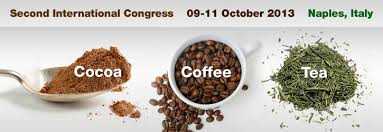Martínez-López S.1, Gómez-Juaristi M.1, Sarriá B.1, Permanyer, J. 2, Mateos R.1, Bravo L.1 1 Department of Metabolism and Nutrition, Institute of Food Science, Technology and Nutrition (ICTAN), Spanish National Research Council (CSIC). Madrid (Spain) 2Department of Nutrition, School of Pharmacy, Universidad de Barcelona (Spain) E-mail: lbravo@ictan.csic.es
Soluble cocoa products are rich in phenolic compounds, but they also contain important amounts ofmethylxanthines (MX). Although there are numerous studies on the bioavailability of cocoa polyphenols, little is known on the bioavailability of MX. In the present study we evaluated the bioavailability of MX in humans after consuming two soluble cocoa products: CC-L, containing naturally present MXlevels, and CC-MX, enriched in MX.
A crossover, randomized, controlled, double-blind study was carried out in non-smoker, non- vegetarian men and women (n=13), aged 18-45, with BMI 18-25 kg/m2. On two different days, after an overnight fast, volunteers consumed one serving of CC-L (15 g) or CC-MX (25 g) in 200 mL of defatted milk. On a third day, they ingested 200 mL of milk (control). During the intervention days and the two previous daysmethylxanthine-rich-foods were restricted from their diets in order to reduce inter and intra-individual differences. On each intervention day, urine samples were collected in 24h urine collection containers at different time intervals (t=0, 0-4, 4-8, 8-12 and 12-24 hours). Blood samples were also collected and results have been presented elsewhere[1].MX and derived metabolites in urine were extracted by a SPE procedure based onThevis, M. et al [2] and then identified using LC-MS. The extracted urine samples were analysed by HPLC and quantified using known standards.
Theobromine (TB), theophylline (TP), caffeine (CF) and their secondary metabolites, such as monomethylxanthines and monomethyluric,dimethyluric and trimethyluric acids were detected in urine samples at all studied time points after consuming both cocoa products. As expected,higher amounts of MXwere excreted after CC-MX consumptionthan CC-L, being TB the predominant MX compared with the rest. Monomethylxanthines were the most abundant group of metabolites compared to methyluric acids (mono-, di- and trimethyl uric acids) appearing in urine from the first interval(0-4h) until 24h after intake with both cocoa products. These results pointedto a rapid absorption, partial metabolization and quick elimination of MX and their metabolites,observing a higher excretion at intervals 0-4h and 4-8h,a decreaseat interval 8-12h and newlyincreasing at 12-24h, speciallythe metabolites, possibly due to the biotransformation of their precursors, since MX-rich foods were avoided on the intervention day.
It can be concluded that MX in cocoa are highly bioavailable, partially metabolized and rapidly excreted in urine, with a sustained urinary excretionfor as long as 24 hour after cocoa intake. In addition, there is a direct relationship between the content of the MX in cocoa and amount of metabolites and their precursors excreted in urine.
Funded by Nutrexpa, S.L. Approved by Ethics Committee of Hospital Puerta de Hierro (Madrid).
References
[1] The 5th International Conference on Polyphenols and Health, Barcelona (Spain). October 2011.
[2] Thevis, M. et al. Electrospray ionization mass spectrometric characterization and quantitation of xanthine derivatives using isotopically labelled analogues: an application for equine doping control analysis. Rapid Commun Mass Spectrom.2004,18, 1553–1560.

















